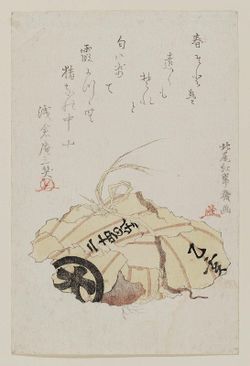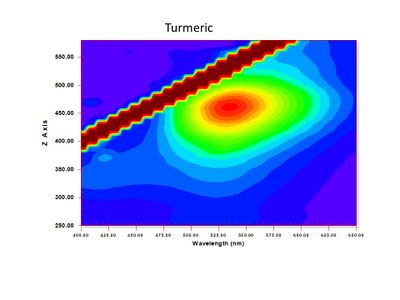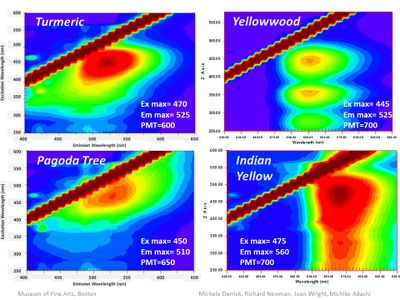Difference between revisions of "Category:Turmeric: Ukiyo-e colorant"
| (11 intermediate revisions by the same user not shown) | |||
| Line 1: | Line 1: | ||
| − | [[File:SC207261.jpg|right| | + | [[File:SC207261.jpg|right|250px|link=Shigemasa, Bundle Tied with Straw; Calendar for 1815, 11.20149|Bundle Tied with Straw by Kitao Shigemasa]] |
| − | <font size="3">'''[[Turmeric]]'''</font> 鬱金(''ukon''): A yellow dye obtained from the root of the ''Curcuma | + | <font size="3">'''[[Turmeric]]'''</font> 鬱金 (''ukon''): A yellow dye obtained from the root of the ''Curcuma longa'' (or ''C. domestica'') plant native to India. Turmeric is thought to have made its way to Japan through Okinawa by way of China from Thailand. The primary color component in turmeric is curcumin.Turmeric produces a bright deep yellow that has a high tinting strength. |
Turmeric and [[:Category:Orpiment: Ukiyo-e colorant|orpiment]] have been the most commonly detected yellows as a single colorant or as a mixture of the two. In addition to mixtures with orpiment, turmeric was frequently overprinted or mixed with [[:Category:Dayflower: Ukiyo-e colorant|dayflower]] and [[:Category:Safflower: Ukiyo-e colorant|safflower]] to create [[:Category:Dayflower/Turmeric: Ukiyo-e colorant|green]] and [[:Category:Other Reds: Ukiyo-e colorant|orange]]. | Turmeric and [[:Category:Orpiment: Ukiyo-e colorant|orpiment]] have been the most commonly detected yellows as a single colorant or as a mixture of the two. In addition to mixtures with orpiment, turmeric was frequently overprinted or mixed with [[:Category:Dayflower: Ukiyo-e colorant|dayflower]] and [[:Category:Safflower: Ukiyo-e colorant|safflower]] to create [[:Category:Dayflower/Turmeric: Ukiyo-e colorant|green]] and [[:Category:Other Reds: Ukiyo-e colorant|orange]]. | ||
| − | '''For | + | '''For additional information see:''' [[Turmeric]], [[Turmeric (Curcuma longa) LC]], Uemura Dye Archive: [[Ukon (Turmeric) - center (20 C)|Turmeric 20]], [https://powo.science.kew.org/taxon/urn:lsid:ipni.org:names:796451-1 ''Curcuma longa'' (Kew)] |
| + | <br> | ||
<br> | <br> | ||
| Line 43: | Line 44: | ||
== Analysis == | == Analysis == | ||
| − | Excitation Emission Matrix (EEM) spectroscopy can easily identify turmeric due to its high fluorescence and clear, consistent pattern. Another yellow colorant thought to have been traditionally used, [[Amur cork tree|Japanese yellow wood]] or kihada also fluoresces very brightly but | + | Excitation Emission Matrix (EEM) spectroscopy can easily identify turmeric due to its high fluorescence and clear, consistent pattern. Another yellow colorant thought to have been traditionally used, [[Amur cork tree|Japanese yellow wood]] or ''kihada'' (黄檗) also fluoresces very brightly but produces a very different EEM pattern, making it easy to distinguish between the two materials. Yellow wood has not been detected so far. |
<gallery mode="packed" heights="200px" style="text-align: left"> | <gallery mode="packed" heights="200px" style="text-align: left"> | ||
Turmeric EEM ref.jpg|<center>3D EEM plot for Turmeric</center> | Turmeric EEM ref.jpg|<center>3D EEM plot for Turmeric</center> | ||
| Line 49: | Line 50: | ||
</gallery> | </gallery> | ||
| − | == | + | ==Images of Turmeric == |
<gallery> | <gallery> | ||
| − | File: | + | File:Turmeric plant.jpg|''Curcuma Longa'' |
| + | File:CurcumLonga_McBJul02040066.jpg|''Curcuma Longa'', <small>by National Tropical Botanical Garden</small>|link=https://ntbg.org/database/plants/detail/Curcuma-longa | ||
| + | File:13 Turmeric root_detail.jpg|Turmeric rhizomes | ||
File:turmeric_pieces.jpg|Cut turmeric rhizomes | File:turmeric_pieces.jpg|Cut turmeric rhizomes | ||
File:turmeric_powder.jpg|Ground turmeric | File:turmeric_powder.jpg|Ground turmeric | ||
File:turmeric.jpg|Paper dyed with turmeric | File:turmeric.jpg|Paper dyed with turmeric | ||
| + | File:NMAH-AHB2017q005550.jpg|Turmeric, <small>by National Museum of American History</small>|link=https://americanhistory.si.edu/collections/nmah_1323752 | ||
| + | File:OCxJeYTBz_A-HD.jpg|Turmeric processing (video), <small>by Foodtechwaale</small>|link=https://youtu.be/OCxJeYTBz_A</small> | ||
</gallery> | </gallery> | ||
==List of Prints == | ==List of Prints == | ||
Below is a list of prints where turmeric was detected. | Below is a list of prints where turmeric was detected. | ||
Latest revision as of 21:26, 12 April 2024
Turmeric 鬱金 (ukon): A yellow dye obtained from the root of the Curcuma longa (or C. domestica) plant native to India. Turmeric is thought to have made its way to Japan through Okinawa by way of China from Thailand. The primary color component in turmeric is curcumin.Turmeric produces a bright deep yellow that has a high tinting strength.
Turmeric and orpiment have been the most commonly detected yellows as a single colorant or as a mixture of the two. In addition to mixtures with orpiment, turmeric was frequently overprinted or mixed with dayflower and safflower to create green and orange.
For additional information see: Turmeric, Turmeric (Curcuma longa) LC, Uemura Dye Archive: Turmeric 20, Curcuma longa (Kew)
Examples of Turmeric in Ukiyo-e Prints

|

|

|

|

|
Analysis
Excitation Emission Matrix (EEM) spectroscopy can easily identify turmeric due to its high fluorescence and clear, consistent pattern. Another yellow colorant thought to have been traditionally used, Japanese yellow wood or kihada (黄檗) also fluoresces very brightly but produces a very different EEM pattern, making it easy to distinguish between the two materials. Yellow wood has not been detected so far.
Images of Turmeric
List of Prints
Below is a list of prints where turmeric was detected.
Pages in category "Turmeric: Ukiyo-e colorant"
The following 56 pages are in this category, out of 56 total.
E
- Eisen, Early Winter: The Day of the Boar in the Tenth Month, from the series Customs of the Four Seasons and Children at Play, 11.25587
- Eisen, Fujieda: Kichô of the Owariya, from the series A Tôkaidô Board Game of Courtesans: Fifty-three Pairings in the Yoshiwara, 11.17946
- Eisen, Geisha at Night under Plum Blossoms, 11.26691-2
- Eisen, The Song Evening Mist at Asama Peak, on Scrap-paper Fabric with an Itchû-bushi Libretto, from the series A Modern Pine Needle Collection, 11.17878
- Eishi, Shizuka of the Shizutamaya, from the series Beauties of the Yoshiwara as Six Floral Immortals, 21.4917
- Eizan, Kashiku of the Tsuruya, from the series Array of Beauties of the Pleasure Quarters, 11.17716
H
- Harunobu, Beautiful Women of the Yoshiwara, Combing hair (2006.1537.1)
- Harunobu, Parody of the Three Evening Poems: Teika, Jakuren, and Saigyô, 11.19703
- Harunobu, The Eleventh Month, from an untitled series of Twelve Months, 11.20120
- Harunobu, The Tenth Month, from an untitled series of Twelve Months, 11.20124
- Harunobu, Young Man Playing a Shakuhachi, 21.4677
- Harunobu, Young Woman Riding a Turtle (Parody of the Story of Urashima Tarô), 21.4594
- Hiroshige I, Enjoying the Cool of Evening on the Riverbed at Shijô, from the series Famous Views of Kyoto, 06.890
- Hiroshige I, The Yodo River, from the series Famous Views of Kyoto, 11.2111
- Hiroshige I/Hiroshige II, Ueno Yamashita, from the series One Hundred Famous Views of Edo, 11.35842
- Hokusai, Woman, Child, and Man with Kite, from the series A Collection of Dances, 11.16764
K
- Kiyohiro, The Attributes of the Seven Gods of Good Fortune, 11.19089
- Kiyomasu II, Actor Segawa Kikunojô I in Momo Chidori Musume Dôjô-ji, 06.423
- Kiyomasu II, Actors Tamazawa Saijirô as the Courtesan Chidori and Ichimura Manzô as Takigô Tôshichi; Calendar for 1744, 21.5455
- Kiyomasu II, The Arrival of the Elephant, 58.343
- Kiyomitsu I, Actor Ichikawa Danzô III as Adachi Hachirô, 11.19030
- Kiyomitsu I, Actors Segawa Kikunojô II as the Courtesan Katsuragi and Ichimura Uzaemon IX as Nagoya Sanza, 45.832
- Kiyomitsu I, Actors Ôtani Hiroji III as Okabe no Rokuyata and Nakamura Sukegorô II as Inomata no Koheiroku, 46.1409
- Kiyonaga, A Matchmaking Meeting at a Teahouse by a Shrine, 21.5574
- Kiyonaga, Actors Matsumoto Kôshirô IV as Ukita Sakingo and Sawamura Sôjûrô III as the Ghost of Takao, with chanters Tomimoto Itsukidayû and Tomimoto Awatayû, and accompanist Sasaki Ichishirô, 11.13921
- Kiyonaga, Actors Matsumoto Kôshirô IV as Ukita Sakingo and Sawamura Sôjûrô III as the Ghost of Takao, with chanters Tomimoto Itsukidayû and Tomimoto Awatayû, and accompanist Sasaki Ichishirô, 21.5476
- Kiyonaga, Child Prodigy Minamoto no Shigeyuki Executing Calligraphy, 11.13883
- Kiyonaga, The Brine Maidens, from the series Current Manners in Eastern Brocade, 21.5610
- Kiyonaga, Women Visiting Enoshima, 11.21277
- Kunisada, Actor Sawamura Tanosuke II, from the series Actor Rebuses, 11.42324
- Kunisada, Actors Iwai Kumesaburô II as Agemaki (R), Ichikawa Danjûrô VII as Sukeroku (C), and Onoe Kikugorô III as Shinbei (L), 21.7532-4
- Kunisada, Komurasaki of the Kado-Tamaya, kamuro Kochô and Sayuri, from the series Comparison of Beauties of the Pleasure Quarters, 11.20991
- Kunisada, Moon Viewing at Mukôjima, a Triptych, from the series Moon, Snow and Flowers, 11.15216
- Kuniyoshi, (Actor Ichikawa Ebizô V as) Inuyama Dôsetsu, from the series The Lives of Eight Brave and Loyal Dog Heroes, 11.28841
- Kuniyoshi, Drying Board Suggesting Hiyodorigoe, from the series Women in Benkei-checked Fabrics, 11.36363
- Kuniyoshi, Hosokute: Horikoshi Dairyô, from the series Sixty-nine Stations of the Kisokaidô Road, 11.28766
- Kuniyoshi, Ruan Xiaowu, the Short-lived Second Son, from the series One Hundred and Eight Heroes of the Popular Shuihuzhuan, 64.800
- Kuniyoshi, The Ninth Hour: Noon; Woman Playing with Cat, Fishmonger and Dog, from the series Sundial of Modern Tradesmen, 11.15955
S
- Sharaku, Actors Ichikawa Komazô III as Kameya Chûbei and Nakayama Tomisaburô I as Umegawa, 11.16483
- Sharaku, Actors Ichikawa Komazô III as Kameya Chûbei and Nakayama Tomisaburô I as Umegawa, 21.7236
- Shigemasa, Bundle Tied with Straw; Calendar for 1815, 11.20149
- Shigemasa, Perspective Picture of the Sleeping Dragon Plum in the Plum Garden at Kameido, 11.14975
- Shigenobu I, Puppy Playing with a Ball, 21.9257
- Shinsai, Chapters 16–18, from the series The Tale of Genji, 11.21066
- Shunkō, Actors Ichikawa Danjûrô V as Fukurokuju, Iwai Hanshirô IV as Ryûyô Dôji, and Sawamura Sôjûrô III as Shin'yô Dôji, 11.14971
T
- TEST-Utamaro I, Women Overnight Guests, a Triptych, 21.6328-30
- TEST-Utamaro I, Women Overnight Guests, left panel of triptych, 21.6328
- Toyoharu, The Armor-pulling Scene at Wada's Banquet, 11.14725
- Toyokuni, Actor Arashi Kitsusaburô I as the Monkey Trainer Yojirô, in the Horikawa Scene of the Play Oshun and Denbei, 11.30331
- Toyokuni, Woman Under Maple and Ginkgo Leaves, from the series Comparison of Beauties, 11.13642
- Toyonobu, Rain in the Fifth Month, 11.19048
U
- Ukiyo-e
- Utamaro I, Courtesan Asajiu of the Daimonjiya and Nanatsu-ume Sake by Momenya, from the series Aristocrats of Sake Compared to Courtesans of Six Selected Houses, 11.14267
- Utamaro I, The Geisha Ogie Matsuzô, Mine, and Ito, 11.14373
- Utamaro I, The Heron Maiden from series An Array of Dancing Girls of the Present Day, 11.14364











